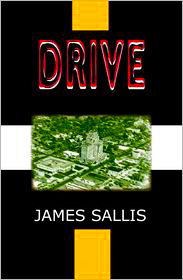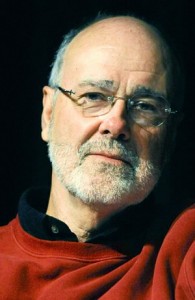“As he sat with his back against an inside wall of a Motel 6 just north of Phoenix…Driver would wonder whether he had made a terrible mistake. Later still, of course, there’d be no doubt. But for now Driver is, as they say, in the moment.”
 As a long-time fan of author James Sallis, I am excited to see how this novel “plays,” now that it has just been released as a film, a first for Sallis. A novelist who writes some of the most compressed novels ever, with big stories conveyed in a few perfect word choices, absolutely right images, and terse but revelatory dialogue, Sallis says more in one sentence than most other authors say in a page or two. His novels are the darkest of the dark, and the lives of his damaged characters are often the messiest of the messy, but his style is powerful and seductive, despite the graphic violence, and I cannot imagine any lover of fine writing not becoming excited by the honesty that underlies his stories and themes and the mysterious attraction of his characters, no matter how sick they may be. Perhaps the film of Drive will lead readers to discover this novel and some of his twelve other novels so that this fine writer will finally find the audience he deserves.
As a long-time fan of author James Sallis, I am excited to see how this novel “plays,” now that it has just been released as a film, a first for Sallis. A novelist who writes some of the most compressed novels ever, with big stories conveyed in a few perfect word choices, absolutely right images, and terse but revelatory dialogue, Sallis says more in one sentence than most other authors say in a page or two. His novels are the darkest of the dark, and the lives of his damaged characters are often the messiest of the messy, but his style is powerful and seductive, despite the graphic violence, and I cannot imagine any lover of fine writing not becoming excited by the honesty that underlies his stories and themes and the mysterious attraction of his characters, no matter how sick they may be. Perhaps the film of Drive will lead readers to discover this novel and some of his twelve other novels so that this fine writer will finally find the audience he deserves.
In Drive, a quintessentially minimalist novel, a main character known only as “Driver” works as a stunt man by day and as the driver of getaway cars at night. Purely pragmatic and living only in the moment, he has no real dreams and no long-term goals, the result of his violent childhood, which was not a childhood at all. No one gets close to him,  though he occasionally shows signs that he has some feelings for a few other damaged creatures. When it comes to his work, however, he is all business – “I don’t take part, I don’t know anyone, I don’t carry weapons. I drive.”
though he occasionally shows signs that he has some feelings for a few other damaged creatures. When it comes to his work, however, he is all business – “I don’t take part, I don’t know anyone, I don’t carry weapons. I drive.”
Opening dramatically with Driver leaning against a wall in a Motel 6 room, his arm wounded so badly it is useless, with three dead bodies around him, the novel repeats these images like a bizarre refrain throughout, as the background for this scene and the action which follows are revealed. In terse prose, as efficient in conveying information as Driver is in killing those who threaten him, Sallis follows Driver as he moves between Los Angeles and Phoenix, doing jobs.
Episodes from his life hit the reader with the intensity of gunfire and in random order, connected not by transitions but through the character and violent background of Driver as his life unfolds without any linearity to the narrative, its episodes requiring the reader to sort and develop his own picture of Driver’s life, with no beginning, no middle, and an end that can only be imagined. Scenes from Driver’s film assignments overlap with scenes from his real life, sometimes inspiring Driver to reminisce or to try to look forward to see how and why he ended up where he is.

Actions speak louder than words here, but the dialogue, when it occurs, is memorable and dramatic. Scenes in which Driver tries to visit his estranged mother and later his foster family are intensely moving because they emphasize an emotional connection which is otherwise lacking in his life. He is intelligent, and he keeps trying to communicate with people through words, not violence, though the circumstances of his life are almost entirely violent. He has no dreams, forced to believe instead in a brutal reality – he is Borges, the writer/realist, not Don Quixote, the tilter at windmills, he notes. “I don’t think [our lives] are thrust upon us,” he explains in one conversation. “What it feels like to me is, they’re forever seeping up under our feet.”
A dramatic, thoughtful, and powerfully moving examination of the life of someone who has few choices, this novel transcends its darkness and violence to show the continuing desire for connection even among life’s most violent people. And Sallis is already at work on a sequel, set seven years into the future, inspired by a request from the film’s producers.
Note: The film production of this novel, directed by Nicolas Refn and starring Ryan Gosling, is reviewed here: Drive, the film
Also by James Sallis: Driven (the sequel to Drive), The Killer is Dying (at the top of my Favorites List for 2011), What You Have Left, which consists of the three novels of his John Turner Trilogy: Cripple Creek, Cypress Grove, and Salt River. Also Others of My Kind, Willnot Sarah Jane
Photos, in order: The author’s photo by Valere Pennicino/Getty and an interview appear on http://www.latimes.com
The photo from the film, starring Ryan Gosling, is by Richard Foreman from AP Photo/Film District and appears on http://www.buzzsugar.com
